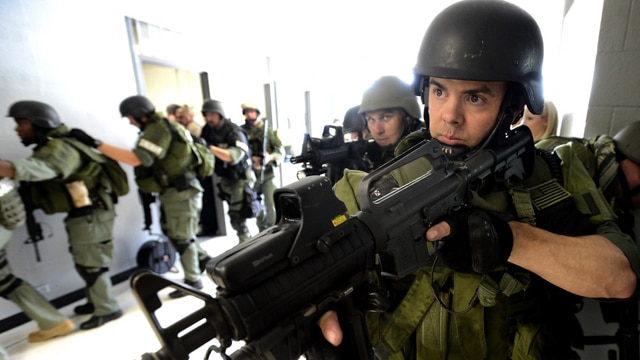
A SWAT training exercise in Alabama in June 2014. (Photo: Mark Almond/AP)
In an interview with The American Conservative magazine published Thursday, “Do Not Resist,” documentary director Craig Atkinson shined a light on how some of the nation’s most heavily armed police units are usually doing pretty routine work.
Atkinson’s documentary highlights the rise of police militarization in America. He and his team went on ride-alongs with SWAT teams and followed several subjects to tell the story. He spoke with American Conservative writer John Payne about the film in November, and talked about the ride alongs he went on while filming.
“Every single time we conducted a search warrant, it was for drugs,” Atkinson told Payne. “We did half a dozen raids while making the film. One time we found a bowl of weed. All the time, destroying the home and arresting people for small quantities of drugs.”
Atkinson pointed to a 2014 ACLU report that says 80 percent of SWAT deployments in America are for search warrants, “and if you look at the search warrants, the vast majority of those are for nonviolent drug offenses,” said Atkinson.
A Washington Post breakdown of the ACLU numbers shows 62 percent of SWAT raids surveyed were for drug searches. In 36 percent of the raids, “no contraband of any kind was found.”
“In fact, just 7 percent of SWAT raids were ‘for hostage, barricade, or active shooter scenarios,’” reads the Washington Post breakdown.
“One thing that surprised me is how forthright the police were with you. Why do you think they were so willing to talk about what is probably a controversial subject, at least to the general population?” asked Payne of Atkinson.
“We were very honest with our intentions, and I think that helped set the tone for our relationship with the police departments,” said Atkinson. “We kept saying that we would offer an authentic portrayal of whatever we did together, and I think they were taking the opportunity to have that, where we wouldn’t re-edit or sensationalize the footage.”
Atkinson talked about a scene in the film where one of the teams he followed in St. Louis County used Google Earth to make sure they had the right house before a raid.
“About seven months after we edited the footage of that SWAT team checking an address on Google Earth, the same team raided the wrong home. Luckily no one was killed, but there have been cases where SWAT teams will raid the wrong home and someone will end up dying because they grabbed a weapon thinking they were under attack,” said Atkinson.
“I just think that when you’re raiding homes on a 200-times-a-year basis, you’re not doing the proper investigative work to ensure that it’s done in a way that’s fair to the community, and it’s just leading to further unjust policing,” he said.
Atkinson says he hopes his film challenges the rising culture of police militarization, saying he hopes it illustrates a “dire need for change.”
The post The routine nature of SWAT raids appeared first on Guns.com.
